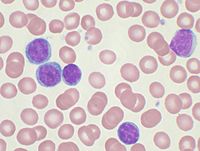
Photo from wikipedia
Background & Aim Leukemia is the most common cancer in childhood, accounting for almost 1 out of 3 cases. Of these malignancies, most are acute lymphoblastic leukemia (ALL), with the… Click to show full abstract
Background & Aim Leukemia is the most common cancer in childhood, accounting for almost 1 out of 3 cases. Of these malignancies, most are acute lymphoblastic leukemia (ALL), with the remaining cases largely acute myeloid leukemia (AML). Despite remarkable advances in treatments, 50%-70% of all children with ALL and AML who relapse after allogeneic hematopoietic stem cell transplantation (HSCT), succumb to their disease. Thus, there is an urgent clinical need of novel therapies for improving prognosis. γδ T cells are a minor subset (1-5%) of CD3+ combining conventional adaptive features with rapid, innate-like responses that place them in the initiation phase of immune cascade. In addition, they recognize tumor cells in a major histocompatibility complex (MHC) independent manner, thereby bypassing the occurrence of Graft versus Host Disease (GvHD). gd T cells is mainly constituted of Vg9Vd2 and Vd1 subpopulations which has demonstrated a potent Graft versus Leukemia (GvL) effect. The Vg9Vd2 subset, which represents the main circulating proportion of gd T cells, recognizes phospoantigens presented by leukemic blasts. The Vd1 subset, conversely, residing within the epithelial tissues, especially at sites of cytomegalovirus (CMV) replication, exerts a protective anti-infections post-transplant role. Methods, Results & Conclusion Here we purpose to develop a novel strategy for ex vivo expanding both Vg9Vd2 and Vd1 gdT-cells in a clinical-scale fashion. The ultimate goal is to post-HSCT administer multiple infusions of expanded gd T cells in order to reduce the risk of leukemia recurrence. We have previously demonstrated that the in vitro exposure of gd T cells to zoledronic acid (ZOL) combined with IL-2, allows robust expansion and activation of the Vd2 subset alone. Herein, we developed a novel protocol for the expansion of both Vd1 and Vd2 by exploiting the mitogenic effect of Concanavalin-A (Con-A), together with ZOL and a cocktail of different cytokines (Table 1). Preliminary results obtained from 5 different healthy donors show that 1) we succeeded in expanding gd T cells up to 50 folds, 2) the use of Con-A is essential for the Vd1 subset expansion, 3) gd T cells ex vivo expanded acquire an effector memory phenotype (Fig 1) and are cytotoxic in vitro against pediatric acute leukemia cell lines. Therefore, these encouraging results lay the foundation for advancing the translational use of gd T cells.
Journal Title: Cytotherapy
Year Published: 2019
Link to full text (if available)
Share on Social Media: Sign Up to like & get
recommendations!